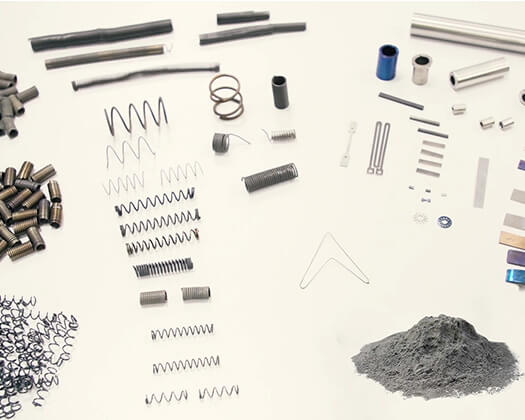What is DSC?
Differential scanning calorimetry (DSC) describes a method of thermal analysis. It is used to determine the heat flow required to heat or cool a sample, hereby phase transformations within a material that lead to energy absorption or release detecting. In SMA technology, this method is used, among other things, to determine the phase transformation temperatures (i.e. the switching points) and the transformation enthalpy of a sample.
Valuable knowledge can be gained from this data, which can be used in material and process development as well as in quality control.
A DSC measurement is usually performed on a specially prepared sample that is in a load-free state in the sample chamber of the machine. It is therefore not used, for example, to characterize the actuator behavior of a component under real load conditions. Special actuator test rigs or tensile tests are used for this purpose.
Application of DSC
Differential scanning calorimetry (DSC) is the most commonly used thermal analysis technique. DSC records enthalpy changes in samples that occur due to changes in their physical and chemical properties as a function of temperature or time. Through this thermal analysis, characterization of the thermal properties of materials is possible. DSC measurements can be used to determine, among other things, the glass transition temperatures and phase transitions as well as the specific heat capacity or the degree of crystallization of materials.
Shape Memory Alloys and DSC
With regard to shape memory alloys (SMA), the DSC method, in addition to other methods such as tensile testing, microscopy or index determination, is used for quality assurance of NiTi SMA (nickel-titanium SMA).
The most common phase change is martensitic transformation, a diffusionless transformation where a large number of atoms change lattice sites in a structured manner in a short time. The displacement of each atom is less than the lattice constant, and most atoms retain their neighbors. The transformation proceeds at the speed of sound and generally occurs only at significant supercooling.
The macroscopic effect of martensitic transformation can be studied by DSC. As in conventional materials development, DSC provides valuable information on the influence as well as the quantification of heat treatment parameters and of forming degrees with regard to shape memory alloys (SMA). In particular, the thermal analysis of the respective SMA can provide further characteristic values by determining the parameters of SMA.
How is DSC applied to shape memory alloys?
The DSC works according to the heat flow principle, which subjects the sample and reference to a controlled temperature program (heating, cooling or isothermal temperature control). The actual measured properties are the sample temperature and the temperature difference between sample and reference. The heat flow difference, which is determined from the measured raw data, represents the caloric changes of the samples. For example, measurements can be carried out for this purpose in a temperature range between -170 °C and 600 °C under a protective atmosphere. The crucible in which the sample is placed is placed in the measuring cell (furnace) of the DSC system together with a usually empty reference crucible.
The DSC is used in the load-free condition of the FGL sample for a sample weight of the order of double-digit mg. In the equally load-free condition, the phase transformation temperatures (PUT) are determined. These are the temperatures at which a phase transformation between martensite and austenite begins, ends, or the rate of transformation reaches its peak (Ap, Mp). During cooling, your FGL component goes through these phases in reverse order. However, the transformation processes do not proceed symmetrically, resulting in hysteresis.
As (austenite start temperature): Transformation martensite – austenite begins.
Af (austenite finish temperature): Transformation martensite – Austenite finishes.
Ms (martensite start temperature): Transformation austenite – martensite starts
Mf (martensite finish temperature): Transformation austenite – martensite finishes






